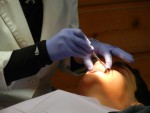
Gum disease or periodontitis can sneak up on people. Early stages often don’t have obvious symptoms. If left untreated, inflammation in the gums can lead to tenderness, persistent bad breath, and even tooth loss.
According to the Centers for Disease Control, about half of all Americans have mild gum disease or worse. Gum disease treatments can include surgery like bone grafts or non-surgical treatments like root planing or Dr Alger’s new treatment option, perioscopy.
What is gum disease?
Periodontitis is a chronic inflammatory disease. It affects the gums and the bones that support your teeth within the jaw.
Symptoms may not be obvious to the patient if there is no bleeding or soreness from brushing or flossing. Often dentists are the first to realize that the gums are having serious issues.
Your body’s inflammatory response to gum disease leads to problems elsewhere. Recent studies show gum disease can worsen diabetes and heart disease. If plaque and tartar have taken hold beneath the gum line, professional treatment is necessary to remove this to prevent further damage.
What are the surgical treatments?
Flap surgery: gums are cut and gently reflected from the tooth root to remove the tartar deposits. The gums are then sutured back in place to fit more closely and close up the pockets between the gums and teeth that form as part of the disease.
Bone and soft tissue grafts: taking bone or tissue from elsewhere and adding it to the root or jaw to fill the pockets. This may allow the body to grow more bone or gum tissue along the graft to fill in the gaps and improve strength.
What are the non-surgical gum disease options?
Drug therapy: including antibiotic treatments marketed as mouthwashes or toothpastes, is sometimes used to treat the bacteria that causes gum disease. However, these treatments leave the plaque and craters in the bone behind. These rough spots will quickly be repopulated with harmful bacteria.
Scaling and planing: smoothes the rough spots caused by the plaque and tartar at and under the root line. Antibiotic therapy keeps bacteria from coming back before the gums can heal. Scaling and root planing is often done with local anesthetic.
Traditional scaling and planing: is done ‘blind’ where the dentist cannot see under the root line. Even a skilled dentist can miss spots or scale root areas that don’t need it. This could lead to repeating the procedure on missed areas or sensitivity where it was done needlessly.
What is perioscopy and how does it help?
Perioscopy involves a miniature camera at the end of a thin probe that allows Dr. Alger to see your teeth and roots under the gum line at over 40 times magnification.
Seeing the teeth and roots in extreme detail allows Dr. Alger and his team to see exactly what areas need to be treated and what areas can be left alone to heal without scaling. This reduces healing time, lessens the chance of repeat treatments and helps patients to avoid surgery and complications.
The scope also shows small but important abnormalities, fractures or decay that might not show up on x-rays. Dr. Alger sees the perioscope system as an important investment in his patients’ overall oral health.
Contact Dr. Fred Alger and his team today to set up an appointment to see if you’re one of the 50 percent of Americans who are losing the battle with gum disease – and if the perioscope system at his office is the weapon you need to win the war for your teeth!




